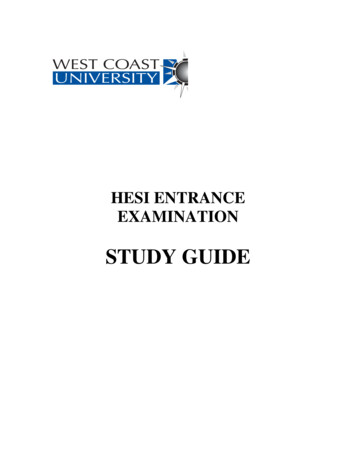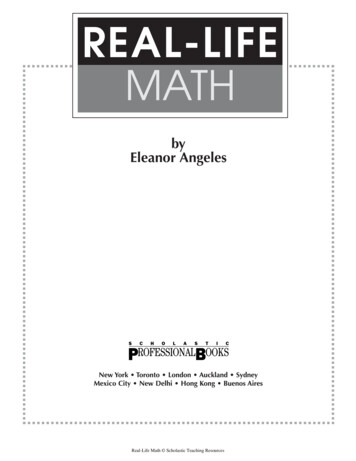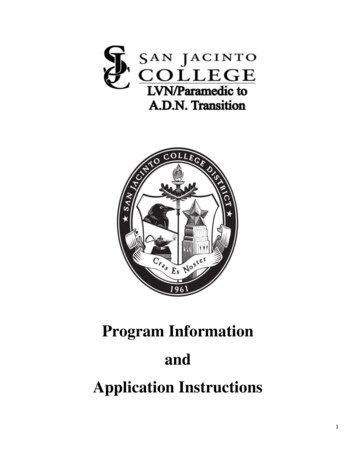
Transcription
HESI ENTRANCEEXAMINATIONSTUDY GUIDE
TABLE OF CONTENTESPageHESI Study PacketIntroductionHESI Test Overview (Math, Reading, Comprehension, Vocabulary,Grammar)Math (face sheets precedes each section—pages bold, underlined;Answers follow each sectionMath diagnostic TestHEST Math Review I-III: Add, subtract, multiply, divide1-23-4, 5-89-14Math IV-VI: Add, subtract, multiply, divide decimals15-19Math VII-XII: Fraction terms; reducing proper and improper fractions; LCDchanging improper to mixed, mixed to improper; ass, subtract, multiply,divide fractions; change fractions to decimals; change decimals to fractions20-33Math XIII: Ratio/Proportion34-36Math XVI: Percentages37-39Math: Helpful information to memorize and understand: chart of fractions,decimals, percents; Roman numerals; measurement conversions40-41Math Review Answer key42-43MATH PRACTIVE TEST 1 (face sheets)44-461. Add, subtract, multiply, divide47-482. Multiply, divide (by & into), and, subtract decimals49-503. Change fractions to decimals; decimals to fractions51-524. Add, subtract, multiply, divide fractions53-545. Percentage55-566. Ratio/Proportion7. Conversion5758-59
8.Rounding60-61MATH PRACTICE TEST 2 (face sheets)62-649. Add, subtract, multiply, divide65-6610. Change decimals to fractions; change fractions to decimals;multiply, divide (by & into) add, subtract decimals.67-6811. Add, subtract, multiply, divide fractions69-7012. Percentage71-7213. Ratio/Proportion73-7414. Conversion75-7615. Rounding77-78Reading Comprehension (face sheets) face sheet precedes eachsection pages are bold, underlined; answers follow each section79-80How to answer reading comprehension questions and sharpen yourreading skills (without really trying)81-83Sample reading test84-86Reading87-92Vocabulary (face sheets) face sheet precedes each section pagesare bold, underlined; answers follow each section93-951. Test 5 (everyday)96-972. Exams 7, 10-14 (everyday)98-1023. Spelling (everyday)103-1074. Multiple Choice Quiz (medical terminology) Chapter One- Four,Twenty-One108-122List of medical terminology (four study only)123-134Grammar (face sheets) face sheet precedes each section- pagesare bold, underlined; answers follow each section135-1371. Exercise One: Problems with Verbs (Part 1)138-139
2. Exercise Two: Problems with Verbs (Part 2)1403. Exercise Three: Problems with Verbs (part 3)1414. Exercise Fourteen: Problems with Introductory VerbalModifiers142-1445. Exercise Fifteen: Problems with Parallel Structure145-1476. Exercise Eighteen: Problems with Structure148-149Answer keys for above grammar section (1-6)150-1587. Lesson 5: Sentence Structure: Dangling Modifiers159-1618. Lesson 5: Sentence Structure: Parallel Structure162-164Answer keys for above grammar section (7-8)1659. Plurals: Ex 2, 3, 4, 5166-16910. Verbs: Ex 12, 13170-172Answer keys for above grammar section (9-10)173-17411. Verbs: (Subjects – Verbs Agreement) lesson 12, Exercise 19175-178Answer key for the above grammar section (11)179-18012. Gerunds and Infinitives181Answer key for above grammar section (12)182
1Math OverviewTypes of questions (no word or story problems)1. Add, subtract2. Add, subtract: decimals, whole numbers to decimals3. Ratio; change fractions to ratio4. Change decimal to percent5. Multiply decimals6. Divide by decimals7. Rounding8. Change fractions to decimals9. Divide by fractions10. Reduce11. Add fractions with unlike denominators12. Divide fractions by whole numbers13. Divide fractions by fractionsHESI Reading Comprehension Overview1. Need a good vocabulary to answer questions2. Read, summarize3. Implies information: Ex. (From the text) In a test, spend more time on essayquestions, which are worth more. (From the question) In a test, in order to getmore points, spend more time on difficult questions.4. Long and short paragraphs5. Other types of questions:A. Definition of wordsB. What is stated vs. impliedC. Fact vs. opinionHESI Vocabulary Test Overview1. Vocabulary in context, or as definition, or correct usage---questions not alwaysclearA. Multiple Choice, Scenario is set upB. Medical terms, some from biologyC. Literary wordsD. Everyday words
2HESI GrammarOverview1. Particularly difficult for ESL (foreign) students2. Questions 1-25 select best answerA. Verb FormsB. Dangling modifiers3. Questions 26-50 Identify and correct incorrect portiona. Subject-Verb agreementb. Parallelismc. Pluralsd. Infinitives (to Verb) or Gerunds (verb ing)e. Particles/prepositions (depend on, not depend in)f. There, their, they’re usage4. Questions 51-55
3MATH DiagnosticDirections:1) Take the diagnostic test that follows.2) Score with the answer key that immediately follows.3) Provide the following information hereon (pages 3,4) for tutor- and-selfevaluation:Total number of problems: 27Number correct:Multiply number correct X 100 Divide by total number of problems %Tutor will review for areas to work on in Math.Areas to work on:,,,NEXT STEP: GO ON TOMATH REVIEW, THENPRACTICE TESTS 1 AND 2.
4DiagnosticKey to followCircle question number (s) missed1Type of tion7Add, subtract, multiply, decimals8 9 10 11 12 16a 17 18 19Concept of decimals, fractions, percentAdd fractions w/ unlike denominators13Multiply fractions14Divide fractions15Concept of ratio16bSubtract decimals21Multiply decimals22Divide by decimals23Percent problem24 25 26Ratio Problem27a 27b
5Number Power Review PretestThis pretest will tell you which chapters of Number Power Review you need to work on and which you havealready mastered. Do all the problems that you can. There is no time limit. Check your answers with the answerkey. Fill out chart at test end. Do all work on these pages.Find an answer to each problem1. 793517 3852. 215 x 89 3. 417 195. 173x 266. 4,208 16Find an answer to each problem.4.2800- 9467. Find the Value of the expression: 3 ( 2.50 - 1.00) ( 10.00 4).8. Write the following numbers in order, from least to greatest.3.03430% 24%0.4439. What percent of this pizza has been eaten?
6Write , or to compare each pair of numbers.10. 32184811.421412.3Solve each Problem.13.2¾ 1 ⅓24231151515. 1 54 814. 2 x 33 516. Keisha bought sixteen cans of soda for a birthday party. Six of these are cans of cola.a. What fraction of the soda is cola (red)? Redb. What is the ratio of cola to flavors that are not cola?Write , , or to compare the pair of decimals.17. 0.650.60518. 0.3290.4820. Which expression can be used to find the width of each board?Boardgap 0.37518”a. 18 (3 x 0.375)4d. 18-(3 x 0.375)4b. 18 (3 x 0.375)3e. 18 –(4 x 0.375)4c. 18- (3 x 0.375)319. 1.141.042
7Solve each problem.21.5.08-2.9223. 2.842 1.4 22. 2.05 x 0.06 24. The Clothes Tree is offering a 25% discount on all women’s sweaters. Including a 6% sales tax,what will Selena pay for a sweater that normally sells for 48.00?For problem 25 & 26, refer to the circle graph.25. What percent of the students at Highland Middle School are in the 8th grade?26. Suppose that next year the enrollment at Highland Middle School increases by 20%. How manystudents will be enrolled at Highland next year?7thGrade156th6 Grade1748th Grade 17027. What is the ratio of the amount that Jonathan saved in May to the amount he saved in January?(Reduce to lowest terms. If necessary)If Jonathan’s take-home pay is 1,500 per month, how much did he save during the 6 monthsshown on the graph?302520151050JanFebMarAprMayJun
8Answer Key1. 1,6952. 19,1353. 21 R 184. 1,8545. 4,4986. 2637. 7.00 ( 4.50 2.50)8. 4%, 30%, 0.34, 0.4, 2/3, ¾9. 62.5%10. 11. 12. 13. 4 – ½14. 2/515. 2/516. a. 3/8 (6/16) b. 3/5 or 3 to 5 (6/10)17. 18. 19. 20. d.21. 2.1622. 0.12323. 2.0324. 38.16 ( 36.00 2.16)25. 34% (170/500 x 100%)26. 600 (500 100)27. 5/3 (25/15)
9Math Review(Note: This page has space for portion and for overall test score.)Directions: 1) Take the portion of the test that follows. Label and do all work on frontand back of same page as problem.2) See pages 42-44 for answer key, to score portion.3) Provide the following information hereon (page 10) for tutor- and selfevaluation:Total number of problems: 24Add, subtract, multiply, divide, whole numbersNumber correct:Multiply number correct X 100 Divide by total number of problems %Tutor will review for areas to work on in math.Areas to work on:,,,OVERALL MATH REVIEW SCORETotal number of problems (overall): 104Number correct:Multiply number correct X 100 Divide by total number of problems %Tutor will review for areas to work on in math.Areas to work on:,,,NEXT STEP: GO ON TOPRACTICE TESTS 1 AND 2.
10Basic Addition and SubtractionBasic Addition462 133Check by: 595462- 133 133462 must be the answer595Steps:1. Line up digits according to place value.2. Add the digits starting from right to left:Ones: 2 3 5Tens: 6 3 9Hundreds: 4 1 5Addition w/ Regrouping835 559Check by: 1,394- 5991835 must be the answer835 5591394Steps:1. Line up the digits according to place value.2. Add:Ones: 5 9 14(carry the 1 to the tens place, which isone place to the left)Tens: 1 3 5 9Hundreds: 8 5 13Basic Subtraction5,234 – 4,112Check by: 1,1225,234 4,112- 4,1125,234 must be the answer1,122Steps:1. Line up the digits according to place value.2. Subtract:Ones: 4 – 2 2Tens: 3 – 1 2Hundreds: 2 – 1 1Thousands: 5 – 4 1Subtraction with Regrouping457 – 29Check by:428417 29457457 must be the answer- 2 9Steps:1. Line up the digits according to place value.2. Subtract:Ones: 7 – 9 (must borrow 1 from the 5In the tens place)Tens 4 – 2 2Hundreds: 4 – 0 4428OnesTensHundredVocabulary:Digit: A numeral, (the number 7 is a digit).Place Value: Each digit in a number occupies aposition – that position is called its place value.HESI Hints:1 Ten 10 ones1 Hundred 100 ones1 Thousand 1000 onesNow you try!1. 1,803 156 2. 835 145 3. 1,372 1394. 123 54 23 5. 673 – 241 6. 547 – 88 6 597. 222 – 114 8. 12,478 – 467
11Basic Multiplication(Whole Numbers)23 X 5123x 5115623 X 45623x 45311524,92028,035Steps:1. Multiply one digit at a time.2. Multiply (5 X 23)Ones: 5 x 3 15 (carry the 1 to the tens placeand write the 5 in the ones place)Tens: 5 x 2 10 1 11Steps:1. Multiply 623 X 55 x 3 155 x 2 10 1 (carried over) 115 x 6 30 1 (carried over) 31 (doesn’t needto be carried over)2. Multiply 623 x 4 (remember to line up the onesdigits with the four by using zero as theplaceholder):4 x 3 124x2 8 1 94 x 6 243. Add the two products together:3,115 24,920 28,035 is the final productVocabulary:Product: The answer to a multiplication problem.HESI Hints:Remember, the placeholders help keep the problem aligned. If you do not skip a space, the answerwill be incorrect. Below is an example of a well-aligned problem.Note: Timetables are crucial for doing multiplication, division, fractions, etc. Please notify the tutor ifyou do not know timesheets by heart at least through 9 x 9.
12301 x 451301x 45130115050 120400135,751Steps:1. Multiply 301 x 1¾ 1x1 1¾ 1x0 0¾ 1x3 32. Multiply 301 x 5¾ 5 x 1 5 ( rememberto use a zero for aplaceholder)¾ 5x0 0¾ 5 x 3 153. Multiply 301 x 4¾ 4x1 4¾ 4x0 0¾ 4 x 3 124. Add the three productstogether:¾ 301 15,050 120,400 135,751 isthe final productNow You Try!1. 846 x 7 2. 325 x 6 3. 653 x 12 4. 806 x 55 5. 795 x 14 6. 999 x 22 7. 582 x 325 8. 9,438 x 165
13Basic Division(Whole Numbers)40 8 Steps:1. Set up the problem. (Review the vocabulary section).2. Use a series of multiplication and subtraction problems tosolve a division problem.3. 8 x ? 40Multiply: 8 x 5 40Subtract: 40-40 0The quotient (or answer) is 5672 6 Steps:1. Set up the problem.2. Begin with the hundreds place:o 6 x ? 6; we know 6 x 1 6; Therefore, place the1(quotient) above the 6 hundred (dividend). Place theother 6 under the hundred and subtract: 6-6 0o Bring down the next number which is 7; 6 x ? 7.There is no number that can be multiplied by six thatwill equal seven exactly, so try to get as close aspossible without going over 7. Use 6x1 6 and set it upjust like the last subtraction problem. 7-6 1o Bring down the 2 from the dividend which results inthe number 12 (the 1 came from the remainder of 76 1).o 6x? 12;? 2 The two becomes the next number in thequotient. 12- 12 0. There is not a remainder.o The quotient (or answer) is 112.VocabularyQuotient: The answer to a division problem.Dividend: The number being divided.Divisor: The number by which the dividend is divided.HESI Hints:The 5 represents the divisor, the 45 represents the dividend, and the 9 represents thequotient. It is the best not to leave a division problem with a remainder, but to end it asa fraction or a decimal point instead. To make the problem into a decimal, just add adecimal point and zeros at the end of the dividend and continue. If a remaindercontinues to occur, round to the hundredths place.Example:233.547 233.55 (the 7 rounds the 4 to a 5)Steps to Division1. Division2. Multiplication3. Subtraction4. Bring down
14174 5Steps:1. Set up the problem.2. 5 does not divide into 1, but does divide into 17.3. 5 x 3 15 Write the 3 in the quotient. (It is written abovethe 7 in seventeen because that is the last digit in thenumber).o 5 x 3 15o 17 – 15 24. Bring the 4 down. Combine the 2 (remainder from 17-15)and 4 to create 24.5. Five does not divide evenly into 24; therefore try to getclose without going over.o 5 x 4 20o 24 – 20 46. There is a remainder of 4, but there is not a number leftin the dividend. Add a decimal point and zeros andcontinue to divide.7. The quotient (or answer) is 34.8 (thirty-four and eighttenths).Now You Try!1. 132 11 2. 9,618 3 3. 2,466 2 4. 325 13 5. 5,024 8 6. 3,705 5 7. 859 4 8. 6,987 7
15Math ReviewDirections: 1) Take the portion of the test that follows. Label and do all work on frontand back of same page as problem.2) See pages 42-44 for answer key, to score portion.3) Provide the following information hereon (page 16) for tutor-and-selfevaluation:Total number of problems: 16Add, subtract, multiply, divide decimalsNumber correct:Multiply number correct X 100 Divide by total number of problems %Tutor will review for areas to work on in math.Areas to work on:,,,Next step: Go to Math Review,Then Practice Tests 1 & 2
16Addition and Subtraction of Decimals2.6 3.15.75 12.3412.34 5.0017.347.21 – 4.017.21- 4.013.2012 – 8.991 9 1012.00- 8.993.01Steps:1. Line up the decimal points.o It might be difficult to line up the5 because it does not have adecimal point. Remember thatafter the ones place; there is adecimal point. IN order to helpwith organization, add zeros.Example: 5 5.002. Add the hundredths: 4 0 43. Add the tenths: 3 0 34. Add the ones: 2 5 75. Add the tens: 1 0 16. Final answer: 17.34 (17 and 34hundredths).Steps:1. Line up the decimal points2. Subtract the hundredths:3. Subtract the tenths: 2 – 0 24. Subtract the ones: 7 – 4 35. Final answer: 3.20 (3 and 20hundredths).Steps:1. Line up the decimal points.2. Since twelve is a whole number, adda decimal point and zeros.3. .00 - .99 cannot be subtracted;therefore, 1 must be borrowed fromthe 12 and regrouped.4. The ones become 1, the tenthsbecome 9, and the hundredthsbecome 10.5. Subtract the hundredths: 10 – 9 16. Subtract the tenths: 9 – 9 07. Subtract the ones: 11 – 8 3o 1 was borrowed from the tens inorder to subtract the 8.Final answer: 3.01 (3 and 1 hundredth).Vocabulary:Place value (regarding decimals):Numbers to the right of the decimalpoint have different terms from thewhole numbers to the left of thedecimal point. Each digit in anumber occupies a position; thatposition is called its place eps:1. Line up the decimal points.2. Add the tenths together:6 1 73. Add the ones together: 3 2 54. Final answer: 5.7 (5 and 7 tenths).ThousandsHundredsTensOnes2.6 3.19 8 7 6 . 5 4 3 2HESI Hints:The word “and” when writing thenumber in words stands for thedecimal.Example: 5.7 (five and seventenths)Now You Try!1. 9.2 7.55 2. 2.258 64.58 3. 892.2 56 4. 22 3.26 5. 8.5 7.55 14 6. 18 7.55 7. 31.84 – 2.430 8. 21.36 – 8.79
17Multiplication of DecimalsSteps:75.7 x 2.175.72.1757 15140158.97x1 decimal place 1 decimal place2 decimal placesmove to the lefttwodecimalplaces in the finalproduct.1. Multiply 757 x 21 (do not worryabout the decimal until the finalproduct has been calculated).2. Starting from the right count thedecimal places in both numbersand ass together (2 decimalplaces).Vocabulary:Place value (regarding decimals):Numbers to the right of thedecimal point have different termsfrom the whole numbers to the leftof the decimal point. Each digit ina number occupies a position:That position is called its placevalue.0.0023.40008 000600.00683 decimal places 1 decimal places4 decimal placesxMove four placesto the left.1. Multiply 0002 x 342. Starting from the right, countthe decimal places in bothnumbers and add together (4decimal eps:0.002 x 3.4ThousandsHundredsTensOnes3. Move to the left 2 places and thenplace the decimal.9 8 7 6 . 5 4 3 23. Move to the left 4 places andthen place the decimal.Steps:3.41 x 7Now you Try!1. Multiply 341 x 73.41x723.872 decimal places 0 decimal places2 decimal placesMove two placesto the left.2. Starting from the right, countthe decimal places in bothnumbers and add together (2decimal places).3. Move to the left 2 places andthen place the decimal.1. 0.003 x 4.23 2. 98.26 x 8 3. 8.03 x 2.1 4. 250.1 x 25 5. 0.1364 x 2.11 6. 8.23 x 4 7. 0.058 x 64.2 8. 794.23 x .001
18Division of Decimals1. Set up the division problem.2. Move the decimal point in 2.5one place to the right makingit a whole number.3. “What is done to one sidemust be done to the otherside.” Move the decimal pointone place to the right in 34,making it 340, and then bringthe decimal point up into thequotient.4. Divide normally:o 25 x 1 25o Subtract 34 – 25 9o Bring down the zero to make90o 25 x 3 75 This is as closeto 90 as possible withoutgoing overo Subtract 90 – 75 15o Add a zero to the dividendand bring it down to the 15making it 15j0o 26 x 6 150150 – 150 05. The quotient is 13.62.468 0.2Steps:1. Set up the division problem.2. Move the decimal point in0.2 over one place to theright making it a wholenumber. .02 is now 2.3. Move the same number ofspaces in the dividend.2.468 is now 24.68.4. Bring the decimal point upto the quotient in the newposition.5. Divide normally.Vocabulary:Quotient: The answer to a divisionproblem.Dividend: The number beingdivided.Divisor: The number by which thedividend is divided.The 5 represents the divisor, the 45represents the dividend, and 9represents the quotient. Place value(regarding decimals): Numbers tothe right of the decimal point havedifferent terms than ndthsSteps:ThousandsHundredsTensOnes34 2.59 8 7 6 . 5 4 3 2HESI Hints:The number 25 is a whole number.Though this number could bewritten 25.0, decimals are usuallynot displayed after a whole number.
190.894 0.05Steps:Now You Try!1. Set up the division problem.1. 48 0.4 2. Move the decimal point inthe divisor until it is awhole number.2. 144 0.6 0.05 is now 53. Move the decimal in thedividend the same amountof spaces that were movedin the divisor.0.894 is now 89.44. Divide normally.3. 3.75 0.4 4. 56.2 0.2 5. 2.6336 0.32 6. 591 0.3 7. 0.72 0.8 8. 0.132 0.11
20Math ReviewDirections:1) Take the portion of the test that follows. Label and do all work onfront and back of same page as problem.2) See pages 42-44 for answer key, to score portion.3) Provide the following information hereon (page 21) for tutor-and selfevaluation:Total number of problems:48Number correct:Multiply number correct X 100 Divide by total number of problems Fractions -%Tutor will review for areas to work on in math.Areas to work on:,,,Next step: Go to Math Review,Then Practice Tests 1 & 2
21Basic Fraction Vocabulary and Explanation(terms, improper fractions, reducing, least common denominators, and mixed numbers)TermsNumerator (part)Fraction BarDenominatorExample: 21 is solved using division7Description:o The numerator is the top number of thefraction. It represents the part or pieces.o The denominator is the bottom number of thefraction. It represents the total or wholeamount.o The fraction bar is the line that separated thenumerator and the denominator.(The top number goes inside the box. The bottom An improper fraction occurs when the numerator isnumber goes outside the box.)larger than the denominator. An improper fractionshould always be reduced or made into a mixednumber.The answer is 3.Reducing Fractions using the Greatest Common Description:Factor: a number that divides evenly into anotherFactornumber.Example: Factors of 12:Reduceo 1 x 12 12o 2 x 6 12o 3 x 4 12Factors of 7 and 21:12 {1, 2, 3, 4, 6, 12} Listing the factors helps7 {1,7}determine the greatest common factor between two or21{1,3,7,21}more numbers.The greatest common factor is 7; therefore divide thenumerator and denominator by 7.1 2 , 3 , 4 , 5 , 6 , 7 , 8 , 9 , 1024 6 8 10 12 14 16 18 207 7 1(all represent a half)21 7 3(reducing fractions can also be called reducing afraction to its lowest terms or simplest form.)Reduce1 1 , 2 , 3 , 4 , 5 , 6 , 7 , 8 , 9 , 10Factorsof 12 and 20:1 2 3 4 5 6 7 8 9 1012 {1, 2, 3, 4, 6, 12}20 {1, 2, 4, 5, 10, 20}The greatest common factor is 4 (they do have 1 and 2in common, but the greatest factor is needed).12 4 320 4 5
22Least Common Least Common Denominator Description:(LCD):The Smallest multiple that two numbers Steps for example I1. List the multiples (Multiplication tables) of eachshare.denominator.Determining the LCD is an essential step in theaddition, subtraction, and ordering of fractions. 4: 4 x 1 4, 4 x 2 8, 4 x 3 12, 4 x 4 16, 4 x5 20, 4 x 6 24, 4 x 7 28, 4 x 8 32, 4 x 9 Example I: Find the least common denominator for36, 4 x 10 40 4 (4, 8, 12, 16, 20, 24, 28, 32, 36, 40). This willbe STANDARD FORM throughout for listing3 , 7multiples.4 9 9(9, 18, 27, 36, 45, 54, 63, 72, 81, 90)2. Compare each for the least common multiple 4 (4, 8, 12, 16, 20, 24, 28, 32, 36, 40) 9(9, 18, 27, 36, 45, 54, 63, 72, 81, 90)3. The least common denominator between 4 and 9 isExample II: Find the least common denominator for36 (4 x 9 36 and 9 x 2 36).3 , 112 8Steps for Example II1. List the multiples of each denominator and find thecommon multiples. 12 (12, 24, 36, 48, 60, 72, 84, 96, 108, 120) 8 (8, 16, 24, 32, 40, 48, 56, 64, 72, 80) Find the least (or smallest) common multiple.2. The least common denominator between 12 and 8 is24 (12 x 2 24 and 8 x 3 24).Changing Improper Fractions into Mixed Description:Numbers (An improper fraction has a larger Steps for Example I We cannot leave the fraction in this form,numerator than denominator.)therefore we turn it into a mixed number throughdivision. (The top number goes in the boxExample I.(numerator) the bottom number (denominator)32stays out).17 Æ 5 17 Æ 3 The 3 becomes the whole number.5155 The remainder becomes the numerator.02 The denominator stays the same.Changing Mixed Numbers into Improper Description:Fractions(A mixed number has a whole number and a Steps for Example I To make a mixed number into an improperfraction combined.)fraction, multiply the denominator and wholeExample Inumber together, and then add the numerator. Place this new numerator over the denominator,which stays the same in the mixed number.175 2/3 Æ 5 2 (5 x 3) 2 17 Æ x 33
23Addition of FractionsAddition with common denominatorsSteps:1. Add the numerators together 3 2 52. The denominator stays the same, 7.3. Answer: 5/7 (five—sevenths)3 2 57 7 7Addition with unlike denominators1 75 101x2 25 x 2 107x1 710 x 1 102 7 910 10 10Steps:1. Find the least common denominator bylisting the multiple of each denominator.o 5: 5, 10, 15, 20, 25, 30o 10: 10, 20, 30, 40, 50o The least common denominator is 10.2. If the denominator is changed, thenumerator must also be changed by thesame number. Do this by multiplying thenumerator and denominator by the samenumber.1x 2 25 x 2 103. Since the denominator of the secondfraction is 10, no change is necessary.4. Add the numerator together and keep thecommon denominator.5. Reduce if necessary.Vocabulary:Numerator: the top number in a fractionDenominator: the bottom number in a fractionCommon Denominator: two or more fraction that have the same denominatorLeast common denominator: the smallest multiple that two numbers share.NOTE: never add denominators; they must be the same for addition and subtraction before youadd or subtract.
24Addition of Mixed NumbersSteps:1551 X 11 14 25 8 20421810X2 102516 2202021620 32120 41201. Findacommondenominator of 4 and 10 bylisting the multiples of each. 4: 4, 8, 12, 16, 20 10: 10, 20, 30.2. Calculate the new numeratorofeachfractiontocorrespond to the changeddenominator.3. Add the whole numberstogether, and then add thenumerators together. Keepthe common denominator20.4. The Numerator is largerthanthedenominator(improper), change theanswer to a mixed number.(reviewvocabularyifnecessary).Now you try it!1. 1 512 122. 710 21 213. 1 4 2 54. 5 3 7 145. 4 6 5 76.71 287.5212 122 1 98.49121 313
25Subtraction of FractionsSubtractingfractionscommon denominatorswith Steps:1. Subtract the numerators:2. Keepthesamedenominator.3. Reduce the fraction bydividing by the greatestcommon factor:Subtracting fractions with unlike Steps:denominators1. Find the least commondenominator by listing themultiplesofeachdenominator:2. Change the numerator toreflectthenewdenominator. (what is doneto the bottom must be don’tto the top of a fraction).3. Subtractthenewnumerators: 10-3 7.The denominator stays thesame.Vocabulary:Numerator: the top number in afraction.Denominator: the bottom numberin a fraction.Common Denominator: two ormore fractions that have the samedenominator.Least Common Denominator: thesmallest multiple that two numbersshare.Factor: a number that dividesevenly into another number.Example: 12 6 2 (6 and 2 arefactors of 12).HESI Hints:Fractions as a whole:1515 One Wholeo Notice in problem 3 that weadded 15 to both thenumeratorandthedenominator. We did thisbecause it is one whole andit is the same denominator.
26Borrowing from Whole NumbersNow you try it!Steps:524 331. Find5theleast1. 32. 12525X3 5520cannot10subtracted from 10,15therefore one must bewhole510 1515 41525152. 283. 172534X53 335.12numerator15borrowed numeratortothe(10 15 25)42515–313 315154. 106. 991 54. 31the fraction.the 3–number,the borrowed one to17–37 37making it 4, and add3. Add 20beborrowed from the42–common denominator5715 –3 18 9thebe7.subtracted.251– 1278.30125 7–1334
27Multiplication of FractionsSteps:Vocabulary:Multiply1. Multiply the numerators together:o 4x1 42. Multiply the denominators together:o 5 x 2 10Numerator: the top number ina fraction.Denominator: the bottomnumber in a fraction.Factor: a number that dividesevenly into another number.3. Reduce the product by using thegreatest common factor:Steps:Multiply1. Make the whole number 5 into afraction by placing a 1 as thedenominator.2. Multiply the numerators:5 x 4 203. Multiply the denominators:1 x 13 134. Change the improper fraction into amixed number.HESI Hints:“Multiplying fractions is noproblem. Top times top andbottom times bottom.”To change an improperfraction into a mixed number,divide the numerator by thedenominator.The quotient becomes thewhole number. The remainderbecomes the numerator, andthe denominator stays thesame.
28MultiplySteps:1. Change the mixed numbers intoimproper fractions:Now You Try!1. 3/5 x 2/3 2. 7/9 x 1/9 3. 6 x 4/5 4. 1 2/5 x 5 5. 2 1/7 x 1 3/4 2. Multiply the numerators anddenominators together:o 17 x 47 799o 8 x 6 48 (denominator)o Change the improper fractioninto a mixed number.6. 4 4/5 x 1 4/6 7. 3 1/3 x 2 8. 1 8/12 x 4 1/2
29Division of Fractions1/2 3/81/2 3/81/2x8/3 8/61 5/6 ¾1 5/6 3/411/6 3/411/6 x 4/3 44/182 8/18 2 4/912 2 3/812/1 19/812/1 x 8/19 96/195 1/19Steps:1. Inverse or flip (or take the reciprocal) of the second fraction.o 3/88/32. Rewrite the new problem and multiply:o 1 x 8 8 (numerator)o 2 x 3 6 (denominator)Steps:1. Change the mixed number into an improper fraction:o 1 5/6 ( 1 x 6 )v 5 11/62. Rewrite the new problem with the improper fraction.3. Inverse or flip the second fraction.4. Multiply the numerator and the denominators together:o 11 x 4 44 (numerator)o 6 x 3 18(denominator)5. Change the improper fraction into a mixed number. Reduce themixed number.Steps:1. Change the whole number into a fraction and the mixednumber into an improper fraction.2. Inverse of flip the second fraction.3. Multiply the numerators and then denominators together:o 12 x 8 96o 1 x 19 194. Change the improper fraction into a mixed number.VocabularyNumerator: the top number in a fraction.Denominator: the bottom number in a fraction.Reciprocals pairs of numbers when multiplied together equal 1.Factor: a number that divides evenly into another number.
30HESI Hints“Dividing fractions— (flip) or inverse the second and multiply.”Example:1 / 2 3 / 8 Inverse 3 / 88/3Then Multiply 1/2 x 8/33/88/3 3/8 x 8/3 24/24 1These two numbers are reciprocals of each other, because when they are multiplied together, theyequal 1.Now You Try!1. 4/5 1/7 2. 12/15 3/5 3. 7/8 1/6 4. 1 1/5 5. 8 1/4 6. 2 1/4 1/6 7. 10 3 1/3 8. 12 1/3 2
31Changing Fractions to DecimalsChange ¾ to a decimalSteps:1. Change the fraction into adivision problem.2. Add a decimal point afterthe 3 and add two zeros.o Remember to raise thedecimal into th
HESI Test Overview (Math, Reading, Comprehension, Vocabulary, Grammar) Math (face sheets precedes each section—pages bold, underlined; Answers follow each section Math diagnostic Test HEST Math Review I-III: Add, subtract, multiply, divide Math










